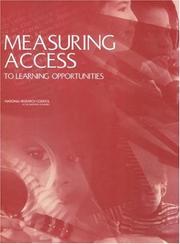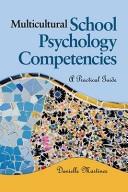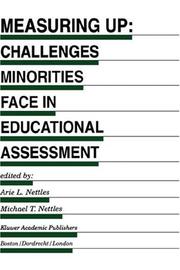Book
Year: 2021 Publisher: [Washington, D.C.] : United States Commission on Civil Rights,
Abstract | Keywords | Export | Availability | Bookmark
 Loading...
Loading...Choose an application
- Reference Manager
- EndNote
- RefWorks (Direct export to RefWorks)
Discrimination in school discipline --- School-to-prison pipeline --- Educational equalization --- Minority students --- Sexual minority students --- Students with disabilities --- School discipline --- Discipline. --- Government policy

ISBN: 0309088976 9786610209064 1280209062 0309505399 9780309505390 9781280209062 6610209065 9780309088978 0309168155 Year: 2003 Publisher: Washington, D.C. : National Academies Press,
Abstract | Keywords | Export | Availability | Bookmark
 Loading...
Loading...Choose an application
- Reference Manager
- EndNote
- RefWorks (Direct export to RefWorks)
Education, Special Topics --- Education --- Social Sciences --- Educational equalization --- Minority students --- Educational surveys --- Civil rights --- Minorities --- Students
Book
ISBN: 1579226175 9781579226176 9781579223731 1579223737 9781579223748 1579223745 9781579226183 1579226183 1003446094 1000976076 Year: 2011 Publisher: Sterling, Va. Stylus Pub.
Abstract | Keywords | Export | Availability | Bookmark
 Loading...
Loading...Choose an application
- Reference Manager
- EndNote
- RefWorks (Direct export to RefWorks)
The book discusses the history and philosophy of MSS units; describes their operation; asserts the need for integration and coherence across the multiple facets of their work and how their role is influenced by the character and type of their institutions; and considers the challenges and opportunities ahead. The theme Building Bridges, Re-Visioning Community reflects the dual role of MSS. They "build bridges" between underrepresented student populations and the broader institutional environment, between different groups of student populations, and across differences in cultural values and tra
Minority college students --- Minorities --- College students --- Minority students --- Services for --- Education (Higher)

ISBN: 1452231621 1452264732 9781452264738 9781452231624 1412905141 1483318397 9781483318394 Year: 2008 Publisher: Los Angeles SAGE
Abstract | Keywords | Export | Availability | Bookmark
 Loading...
Loading...Choose an application
- Reference Manager
- EndNote
- RefWorks (Direct export to RefWorks)
This is a practical resource guide presenting lecturers and students with material which will help apply the theory of multicultural school psychology and counselling in practice. Its emphasis is on helping educational psychologists to develop and refine multicultural competencies and assessments.
School psychologists. --- Minority students --- Minorities --- Students --- Psychologists, School --- Psychologists --- Counseling of.
Book
ISBN: 1479805564 9781479805563 9781479861316 1479861316 9781479898053 1479898058 Year: 2015 Publisher: New York London
Abstract | Keywords | Export | Availability | Bookmark
 Loading...
Loading...Choose an application
- Reference Manager
- EndNote
- RefWorks (Direct export to RefWorks)
Winner, 2016 Best Authored Book presented by the Society for Research on Adolescence This is what democracy looks like: Youth organizers in Colorado negotiate new school discipline policies to end the school to jail track. Latino and African American students march to district headquarters to protest high school closure. Young immigration rights activists persuade state legislators to pass a bill to make in-state tuition available to undocumented state residents. Students in an ESL class collect survey data revealing the prevalence of racism and xenophobia. These examples, based on ten years of research by youth development scholar Ben Kirshner, show young people building political power during an era of racial inequality, diminished educational opportunity, and an atrophied public square. The book’s case studies analyze what these experiences mean for young people and why they are good for democracy. What is youth activism and how does it contribute to youth development? How might collective movements of young people expand educational opportunity and participatory democracy? The interdependent relationship between youths’ political engagement, their personal development, and democratic renewal is the central focus of this book. Kirshner argues that youth and societal institutions are strengthened when young people, particularly those most disadvantaged by educational inequity, turn their critical gaze to education systems and participate in efforts to improve them.
Educational equalization --- Youth --- Minority high school students --- High school students --- Students --- Minority students --- Political activity --- Education
Book
ISBN: 1108882072 1108898963 1108794785 Year: 2020 Publisher: Cambridge : Cambridge University Press,
Abstract | Keywords | Export | Availability | Bookmark
 Loading...
Loading...Choose an application
- Reference Manager
- EndNote
- RefWorks (Direct export to RefWorks)
Over the past three decades, research efforts and interventions have been implemented across the United States to increase the persistence of underrepresented minority (URM) students in science, technology, engineering, and math (STEM). This Element systematically compares STEM interventions that offer resources and opportunities related to mentorship, research, and more. We organize the findings of this literature into a multi-phase framework of STEM integration and identity development. We propose four distinct phases of STEM integration: Phase 1: High School; Phase 2: Summer before College; Phase 3: First Year of College; and Phase 4: Second Year of College through Graduation. We combine tenets of theories about social identity, stereotypes and bias, and the five-factor operationalization of identity formation to describe each phase of STEM integration. Findings indicate the importance of exploration through exposure to STEM material, mentorship, and diverse STEM communities. We generalize lessons from STEM interventions to URM students across institutions.
Science --- Technology --- Engineering --- MathematicsxStudy and teaching --- Minorities --- Minority students --- Inclusive education --- Students --- Study and teaching --- Education

ISBN: 0792384016 Year: 1999 Publisher: Boston : Kluwer Academic Publishers,
Abstract | Keywords | Export | Availability | Bookmark
 Loading...
Loading...Choose an application
- Reference Manager
- EndNote
- RefWorks (Direct export to RefWorks)
Educational equalization --- Educational tests and measurements --- Minority students --- Test bias --- Social aspects --- Rating of
Book
Year: 2001 Publisher: College Park, MD : ERIC Clearinghouse on Assessment and Evaluation,
Abstract | Keywords | Export | Availability | Bookmark
 Loading...
Loading...Choose an application
- Reference Manager
- EndNote
- RefWorks (Direct export to RefWorks)
Limited English-proficient students --- Minority students --- Students with disabilities --- Rating of.
Book
ISBN: 1610448529 9781610448529 9780871547965 Year: 2015 Publisher: New York
Abstract | Keywords | Export | Availability | Bookmark
 Loading...
Loading...Choose an application
- Reference Manager
- EndNote
- RefWorks (Direct export to RefWorks)
Racism --- Equality --- Social stratification --- Discrimination in education --- Segregation in education --- Minority students
Book
ISBN: 1136965963 9786613044785 1283044781 1136965971 0203850955 9780203850954 9781136965975 9781136965920 1136965920 9781136965968 6613044784 9781283044783 9780415999793 0415999790 9780415999809 0415999804 Year: 2011 Publisher: New York, NY Routledge
Abstract | Keywords | Export | Availability | Bookmark
 Loading...
Loading...Choose an application
- Reference Manager
- EndNote
- RefWorks (Direct export to RefWorks)
What is assessment and how is it a cultural practice? How does failure to account for linguistic and cultural variation among students jeopardize assessment validity? What is required to achieve cultural validity in assessment? This resource for practicing and prospective teachers - as well as others concerned with fair and valid assessment - provides a thorough grounding in relevant theory, research, and practice. The book lays out criteria for culturally valid assessment and recommends specific strategies that teachers can use to design and implement culturally valid classroom as
Educational tests and measurements --- Test bias --- Minority students --- Linguistic minorities --- Multiculturalism --- Evaluation. --- Examinations.

 Search
Search Feedback
Feedback About UniCat
About UniCat  Help
Help News
News